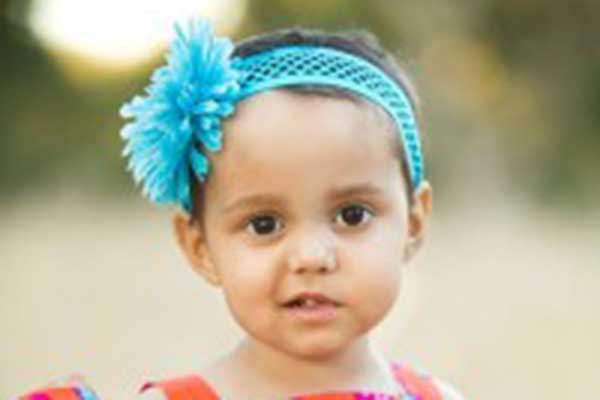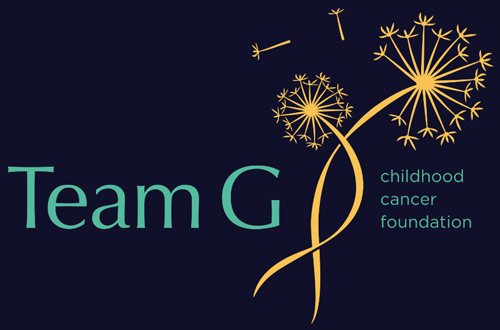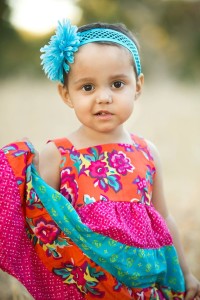Audrey

During the month of November 2014, we honor a “warrior” among us by the name of Little Ms. Audrey. Turning 4 years old this coming March 19th 2015, Audrey’s personality was described as “Miss Sassy Pants.” Always on the go with her older sister, Haley (9 years), Audrey can be found riding her tricycle with Buddy and Ginger, family members in canine form in tow. Audrey still walks the path of towards health away from her diagnosis of Anaplastic Ependymoma on April 8th, 2012. Her main caregivers are Mom, Dad and her Mimi (grandmother). Like many of the stories we have shared before, Audrey’s is one that began when her parents knew simply: something was not right with their child. Audrey’s mother, Jennifer tells Team G just how their journey was set in motion.
When did Ms. Audrey start to show signs that something was not right?
“When she was almost 12 months old, she began to vomit for no reason. When she walked it was off balance with her head at a tilt and it progressively got worse over time. There was a point where we were at her pediatric doctor 9 times in the course of 14 days. The doctors’ check for eye or ear infections, countless blood work, but nothing serious came in the results. During the Easter holiday of 2012, we had come to our limit as we watched Audrey starving, wolf down her food only to throw it all up a short time later. We drove to Madera Children’s Hospital. Once there, we were told immediately that her symptoms may mean there may be something more serious happening and a CT scan was preformed. The mass was discovered.”
Anaplasia refers to the structural differentiation loss within cell or group of cells. The loss of structural differentiation in cells is especially seen in most, but not all malignant neoplasms. Ependymoma is a tumor that arises from the ependyma, a tissue of the central nervous system. Ependymomas make up about 5% of adult intracranial gliomas and up to 10% of childhood tumors of the central nervous system (CNS). Their occurrence seems to peak at age 5 years and then again at age 35. They develop from cells that line both the hollow cavities of the brain and the canal containing the spinal cord, but they usually arise from the floor of the fourth ventricle, situated in the lower back portion of the brain, where they may produce headache, nausea and vomiting by obstructing the flow of cerebrospinal fluid. (Wikipedia.org)
What was the course of action for treatment?
“We had to work with an orthopedic surgeon and neurology specialist who pointed us to Lucille Packard at Stanford. On April 13th 2012, Audrey went in for her first resection and a shunt placed to control the flow of fluid. She came out of surgery not being able to move her left side and swallow on her own. Then she developed hydrocephalus. (Hydrocephalus also known as “water on the brain” is a medical condition in which there is an abnormal accumulation of cerebrospinal fluid (CSF) in the ventricles, or cavities, of the brain. This may cause increased intracranial pressure inside the skull and progressive enlargement of the head, convulsion, tunnel vision, and mental disability. Hydrocephalus can also cause death.) During the course of a one month stay at Stanford, not only was a port placed but a gastrostomy tube as well to help feed Audrey. Next came her first cycle of chemotherapy, as MRI scans revealed that the tumor was growing. A second resection of the tumor was performed on July 16th 2012 at which time, we moved into the Ronald McDonald house before starting 33 rounds of radiation. Because her age and the intensity of treatment she was sedated Monday through Friday for 7 weeks straight. A break came when a MRI scan finally showed that the tumor size was stabilizing. We returned home for a 3 week ‘vacation’ only to have to come back for 3 more months of intense chemotherapy. Audrey was admitted to the hospital several times with dehydration and infections. Her last chemotherapy was January 11th 2013 and her MRI scans every 3 months since only provide good news. Audrey had her feeding tube and port removed. Though she suffers palsy on her left side, she has gained the used of her extremities and couldn’t be happier. Right now, we are moving forward to help repair the damage that the cancer treatment has caused. On September 3rd 2014, Audrey had surgery to correct the scar tissue affecting the spinal fluid from draining. After 4 nights in hospital, we are happy to report that Audrey did amazing and the surgery was a success! “
What are the milestones throughout this entire experience that you would like to share (medical, personal, etc)?
“Being done with treatment was the biggest! It was like getting off a roller coaster! And…all the people we have met along the way. There are definitely still good people doing good things out there.”
Have you discovered ways to keep yourself and your family and Ms. Audrey positive and moving forward that you would like to share?
“Our family was split for so long during the entire process that it really meant a lot to do the “normal” things; preschool, dinner, myself to go back to work part time and simply spending time together as a family that really became important.”
Jennifer added that as a caregiver, the best words of advice or words of wisdom she could provide was that, “You are there to be the best advocate” for your child.

WARRIOR AUDREY
4 rounds
20 pushups
40 squats
60 situps
run 400 meters
(if you are new to the Fight For Gold Challenge do half of each exercise at a comfortable pace)

